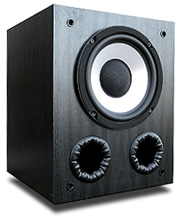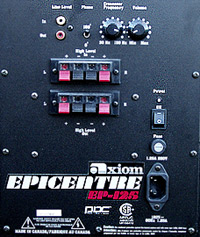 Axiom
Audio Epicenter EP125 Subwoofer Axiom
Audio Epicenter EP125 Subwoofer
Subwoofers may just be the most misunderstood
components of them all. When the uninitiated think of subwoofers, they probably conjure up
visions of adolescents gyrating to the throbbing thump-thump offered up by poorly
designed speakers with exceedingly large and under-damped woofers. But savvy listeners
know that this is not what good bass is all about. While bass may rank low on the
priorities lists of snobbish audiophiles (clean, detailed midrange and smooth, extended
treble top their lists), they also know that no audio system is complete without
good bass, and that there is more to good bass than the feeling of being kicked in
the gut. Much more.
Contained within deep-bass frequencies are spatial cues
that can lend a truly three-dimensional quality to the soundstage. Without low bass, music
can sound as though it was being performed in a high school cafeteria: flat, acoustically
dead, and constricted. Add the proper amount of bass and the apparent size and specificity
of the recorded venue can expand exponentially.
Most listeners have experienced the effects of poorly
defined bass. Bass that is too loud or seemingly loose and ill-defined blurs the
intricacies of the rhythm and thus bogs down and obscures the music's timing. Taut,
well-controlled, articulate bass is quite another thing. It increases the dynamic
contrasts of the music and gives it a sense of liveliness and a heightened sense of
timing, along with more highly differentiated dynamic shadings.
The Axiom EP125
Selling for $380 and rated down to 35Hz, the Axiom EP125 is
a small, powered woofer module designed to augment the bass reproduction of Axiom’s
smaller speakers or to add bass excitement to home theaters. While not rated down to the
20Hz range of music's bottom octave, the EP125 does extend far enough to flesh out the
output from most stand-mounted speakers and even some floorstanding ones.
Designed to squeeze into any system and any room, the
diminutive EP125 (15.25"H x 11.75"W x 12.5"D) weighs in at only 20.5
pounds. Enclosed in the black-oak wood-grained vinyl-finished enclosure is an amplifier
rated at 125W and an 8" aluminum-cone woofer.  Located under the woofer are two of
Axiom’s signature corrugated Vortex Ports. Located under the woofer are two of
Axiom’s signature corrugated Vortex Ports.
On the enclosure's rear panel are the amplifier controls
and inputs. It is with this control center that I encountered my only real quibble with
the EP125. Though it does feature two speaker-level inputs, there is only one low-level
RCA input (as well as an RCA output -- intended, I suppose, for daisy-chaining multiple
subs). I guess Axiom has geared the EP125 toward the home-theater crowd who will only
require one low-level input (connected from their processor’s LFE output), but as a
music-first guy, I would have preferred two RCA inputs that can be fed directly from my
preamplifier outputs. Filling out the rest of the amplifier's control plate is a
continually adjustable low-pass filter (labeled at the control’s extremes of 30Hz and
150Hz), a volume control, a two-position phase switch indicating 0 and 180 degrees, a
power on/off switch, a line fuse, and an IEC connector for the power cord.
I have to acknowledge that the two speaker-level inputs did
accomplish their mission, and the two lengths of speaker wire I used to connect the EP125
to the outputs on my power amplifier did come in at a lower price than would a pair of RCA
interconnects of appropriate length. I used the Axiom EP125 with the company’s M22Ti
SE speakers, a Yamaha DSP-A1 receiver, and a Pioneer DV-525 DVD player.
And the band played on
GRP Live In Session [GRP-D-9532], a studio-recorded live
CD, is filled with good music, well-recorded drums, and powerful electric-bass lines,
which made it a good demo disc for the EP125. All of the previously mentioned benefits of
subwoofing came through on "Oasis." Switching in the EP125 did indeed give the
music a more highly defined character. Where before the presentation was somewhat
bleached-out and vague, the EP125 gave it newfound life, detail, and presence. Even
microdynamic detail was increased. Music had a greatly heightened sense of texture. This
dynamically charged presentation also featured a more highly contrasted resolution.
Without the subwoofer, Abe Laboriels’ bass lines were merely hinted at; with the
EP125's addition, they fleshed out to the point of being visceral. At 5:47 into the song,
the drum kit is featured front and center, and the EP125 gave it a more commanding
presence on stage with a newfound authority and size. The trapset actually seemed to
occupy more space on stage.
The opening bass notes on "Rit Variations" were
impressive for both their weight and detail. Here the bass drum and the bass guitar seemed
to vie for control of the song’s rhythm, and the EP125 did a pretty darned good job
keeping up. While not quite as detailed or clean as larger and more expensive subs can be
(but not always are), it formed a union with the M22Ti SEs for a top-to-bottom wholeness
that was greater than anything I’ve heard from floorstanding speakers in this price
range. In addition to the added weight and authority, the Axiom sub offers greater
adjustability to the equation than any similarly priced floorstanding system is likely to
provide.
"The Beat Goes On" from Patricia Barber's Companion
CD [Blue Note/Premonition 7243 5 22963 2 3] demonstrated something that perplexed me. The
song is structured around a very strong and prominent acoustic bass, and it took the EP125
to fully bring that bass to its intended prominence. But what surprised me was how the
greater bass extension, weight, and power actually brought into greater relief the sound
of the bass strings slapping against the neck of the instrument. These "clicks"
were well above the range of the EP125, but without the sub they just didn’t seem as there.
Just as with the GRP disc, the performers on the stage were
more three-dimensional as each performer occupied a more focused position on stage.
Activating the EP125 had the effect of increasing tonal delineations by sharpening them.
And even where deep bass was not present, dynamic contrasts were again heightened.
At the end of the listening session I couldn’t help
but throw the EP125 to the wolves. Knowing full well that I was asking too much from the
diminutive woofer, I put on James Horner’s Casper soundtrack [MCAD-11240]. The
opening "No Sign of Ghosts" contains some deep synthetic bass. The EP125
surprised me with how well it hung in there. In direct comparison to larger, more
expensive subs, it did lack somewhat, but most listeners would have to be impressed
at what this does at its price. There was a little bass doubling (overloading) at some
points, but most of the time the bass-drum strikes were rendered so cleanly that I could
sense the tautness of the drum skin (which is not too tight!) and the room was
traversed with wave after wave of bass. The rest of the disc is chock-full of bass events
that lend a dark-and-ghastly, foreboding character to the music, and the EP125 did a very
good job of conveying that mood.
Conclusion
Axiom has scored yet again with the EP125 subwoofer. Yes,
even from within Axiom’s own line you can find subwoofers that go louder and lower,
but if you are just looking to fill in some of the more important bass frequencies that
your main speakers omit, the EP125 does a very fine job. With an emphasis on tight and
musical, the EP125 will lend a surprising amount of weight to most affordable
stand-mounted speakers, while it also delivers the other goodies that bass fanatics crave.
Price of equipment reviewedAxiom
Audio Epicenter EP125 Subwoofer - $380 USD
|